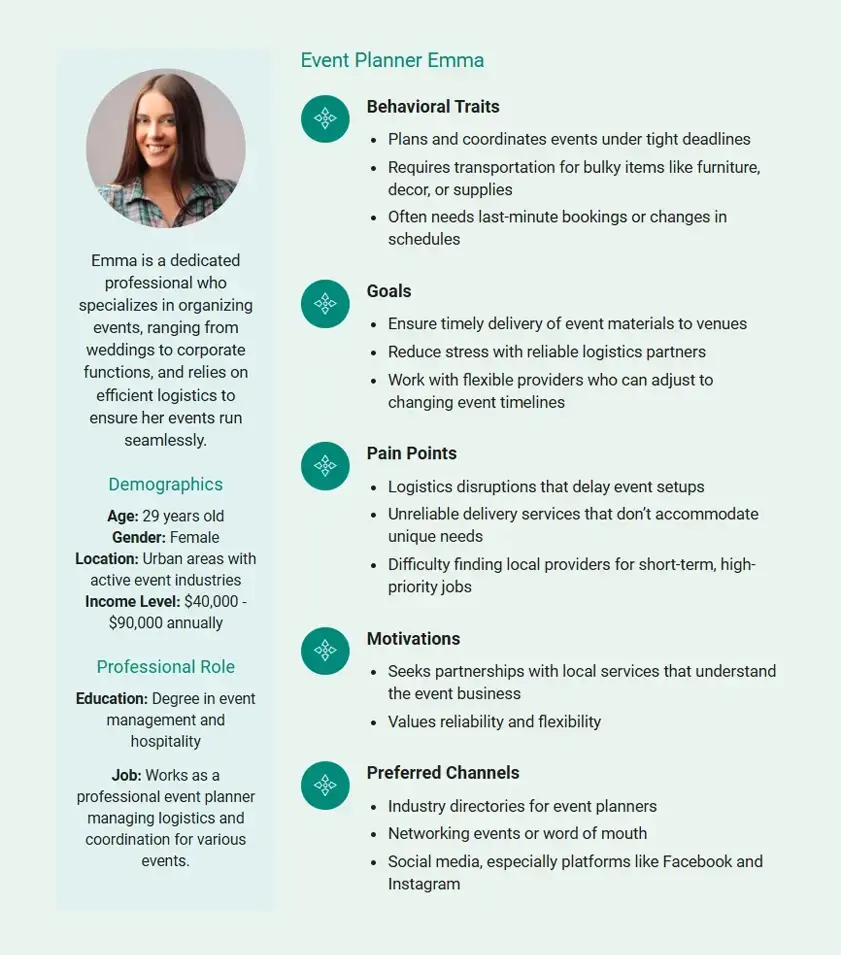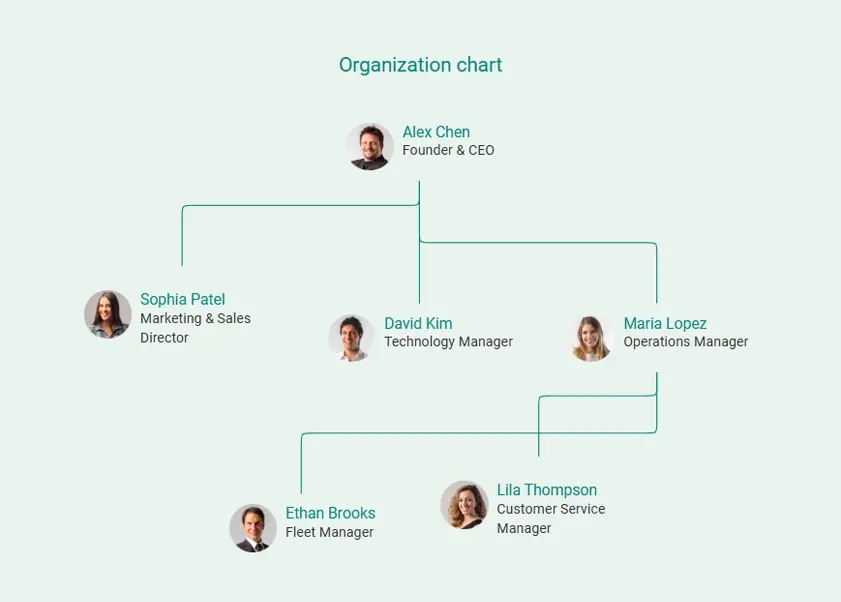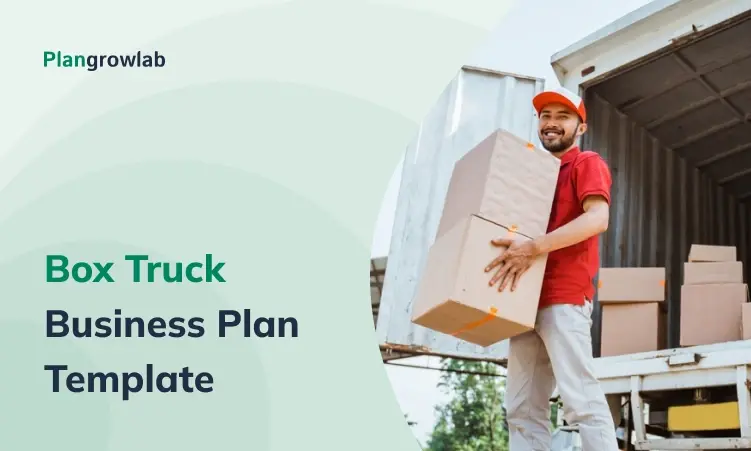With the rise of e-commerce businesses and growing demand for safe, flexible delivery solutions, a box truck business has now turned into a lucrative opportunity for entrepreneurs.
So, if you're the one interested in jumping into this market, you’ll need a solid box truck business plan to get started.
That’s what worked for Alonzo Slaughter Jr., the owner-operator at S.E.T Enterprises Inc. in Georgia.
In our recent conversation, we talked about his journey—how he stayed organized and overcame challenges along the way.
From those insights, I’ve prepared this detailed guide for your help and reference.
What is a box truck business plan?
A box truck business plan is a professional document that serves as a blueprint for starting and growing your box truck company. It outlines your business vision, goals, service offerings, operational details, as well as financial projections in a standard format and clear structure.
In fact, a strong plan ensures that you’re serious about your business and keep a robust strategy to enter the competitive marketplace.
Why do you need a box truck business plan?
Well, launching a business without a plan is like heading out on a long journey without a map. You might move forward, but with no clear path to follow.
Here are a few reasons why a business plan is important for a box truck business:
- Outlines your goals and how to reach them.
- Helps you get enough funding from investors or banks.
- Lets you know what operations need to be done daily.
- Keeps you organized and prepared for challenges.
All in all, a box truck business plan is a valuable tool to make your trucking venture a success.
How to write a business plan for a box truck company?
While writing a business plan for a box truck company, you have to pay careful attention to several crucial steps and components to articulate your idea on paper.
Here’s a guide to cover all your business aspects:
1. Executive summary
Your business plan executive summary would be the core section as it provides a quick, concise overview of what your box truck business is all about.
Though it’s an introductory part, it’s more convenient to write your plan summary at the very end once you’ve completed all the other sections. Why? Because it lets you summarize all the important points easily.
To plan this section, consider including the following key elements:
- Chosen business name and location
- Business model and purpose
- Primary services offered
- Market opportunities
- Promotional efforts
- Financial projections outlook
Simply put, this section serves as an elevator pitch for your entire plan, capturing potential investors’ attention and persuading them to invest in your business.
Hence, keep this plan summary short, simple, and engaging.
“Writing the executive summary was quite harder than I expected because I wanted to include everything—what we do, who we serve, and where we’re headed.
But I realized it’s not about that. It’s about keeping it short and clear enough to grab attention and make people want to keep reading.
Saying we offer reliable delivery or moving services felt too generic.
Thus, I focused on what makes us different, like being available 24/7, tailoring services for small businesses, and having a track record for on-time deliveries."—Alonzo
2. Business overview
The business overview section would be the in-depth analysis of your box truck company, describing its foundational facts and basic information.
Start by highlighting your business concept, the type of services you plan to offer, legal structure (sole proprietorship, LLC, or corporation), as well as location, along with the reason for choosing that place.
After that, clearly jot down your vision, mission statement, and future goals that help define the WHY behind your business.
If you’re an established business, articulate your background history, like when it was started, how it evolved, etc. You can even describe milestones achieved (if any).
In short, this section will help readers get a better understanding of your business and what makes it unique.
“The tricky part was finding the right tone. I didn’t want it to sound too generic, so I included a little of my backstory—like how I started in logistics and saw a gap in the market for dependable, affordable box truck services.
Sharing that personal connection made the overview feel more relatable and helped explain why I was passionate about starting the business."—Alonzo
3. Market analysis
Next, conduct a thorough box truck industry analysis and market research. This will give you valuable insights into the target market, customer segments, emerging market trends, as well as main competitors.
Remember, a well-researched, detailed market analysis section shows potential backers that you have a good idea of the external environment in which your box truck company intends to operate. So, do your homework and position yourself effectively.
While planning this section, try to answer a few questions, like:
- How big is the global trucking business market?
- What’s the size of the box truck industry in the USA? Is it growing or falling?
- Who are your target customers? Small businesses? Local movers? Or e-commerce companies?
- Who’s already doing this in your area? Who are your direct competitors? (i.e., other box truck companies)
- What can you do better than them? What makes you stand out?
Even Alonzo emphasized that having a strong competitive advantage is vital for your business’s success and growth. He said:
“I knew e-commerce and small business growth were driving the need for logistics solutions, but I had to get more specific.
I spent time researching which industries in my area—like retail, furniture stores, and catering businesses—might need flexible delivery services.
I also talked to local business owners to learn about their pain points. Many of them said they struggled with last mile delivery services because big companies were too expensive or inflexible.
That insight gave me a clear picture of how my business could fill that gap."—Alonzo
Moreover, creating a buyer persona profile will help you better understand the ideal clients’ needs and preferences, allowing you to tailor your service offerings and marketing efforts as well.
Here’s an example of a box truck business’s buyer persona:

4. Service offerings
This section is where you have to craft what actually your box truck business plans to offer.
Begin with a precise list of your main box truck service offerings. For example: deliveries, long-distance moving, transportation services for fragile or perishable goods, etc.
Then, discuss how your services help customers and include a brief of how you price your services. Be it hourly rates, flat fees, or charges per mile. You don’t need to state exact numbers here—just enough to give a basic idea.
Further, outline anything (i.e., extra services you provide) that adds value. Do you offer packing and unpacking, assembly, or climate-controlled transport?
Don’t forget to communicate your unique offerings, like handling fragile/oversized items or offering affordable, 24/7 services. This will make your business stand out in the market. Thus, keep it clear, focused, and a little customer-centric.
“Figuring out how to clearly draft my services while keeping it short was a bit of a challenge.
I ended up breaking things into categories: same-day local deliveries, last-mile logistics for small businesses, and on-demand moving help. That made it easier to stay organized, but I also had to add the little details that matter.
For example, I mentioned how I specialize in flexible scheduling for businesses that need deliveries outside regular hours or quick turnaround times.
Those specifics made it feel more real and showed how my services meet actual customer needs."—Alonzo
5. Marketing plan
Your marketing plan clearly articulates how you’re going to attract customers, retain them, and most importantly grow your box truck company.
So, you’ve to develop effective strategies and ways to reach your target customers, bring in ideal clients, and make more money. Here are a few marketing tactics and promotional strategies you may include in this section:
- Online marketing through social media platforms (Facebook, Instagram, and LinkedIn)
- Offline advertising using flyers, local ads, or even word-of-mouth referrals
- Partnerships with businesses that need regular deliveries, like furniture stores or local manufacturers
- Incentive offerings or discounts for first-time clients
- Loyalty programs or referral rewards
Overall, a well-thought-out marketing strategy demonstrates to potential funders that you have a holistic approach to reach your audience effectively and maximize the revenue potential.
“It was difficult to figure out how to promote my business without spending a lot.
So, I kept it simple and started with the basics, like setting up a Google My Business profile and asking my first clients to leave reviews. That helped me show up in local searches and build trust.
Social media marketing was another tool I used—I posted behind-the-scenes looks of deliveries and customer success stories to show people what my business was all about.”—Alonzo
6. Operations plan
The operations plan clarifies how your box truck business operates on a daily or weekly basis. It’s like a behind-the-scenes look at what keeps your business running smoothly.
Here’s what to cover in your box truck operations plan:
- Day-to-day activities or processes (deliveries, handling customer service, etc.)
- Fleet management and maintenance
- Staffing and training
- Tech tools used (GPS trackers or dispatch systems)
- Regulatory compliance (permits, licenses, insurance needed)
By including all these aspects, you show readers that you've thought through all the nitty-gritty stuff and have a system in place to operate your box trucks. Hence, try to make this section more practical and straightforward.
“One specific challenge was figuring out how to balance flexibility with efficiency.
In the box truck businesses, no two days are the same—some jobs are booked weeks ahead, while others pop up last minute.
To keep things manageable, I put together a simple scheduling system that lets me prioritize jobs based on location and timing.
This not only saved on fuel and time but also made sure I could take on more work without overloading myself."—Alonzo
7. Management team
In this management team business plan section, introduce the people responsible for running the business—whether it’s just you or a small team.
A strong, well-experienced management team shows investors that you’ve got the skills and leadership to grow your company, building trust and confidence in your proposal.
As a box truck owner, first, give a quick intro about yourself. Highlight your educational background, industry experience, and relevant skills.
If you have other team members (such as operations manager, dispatcher, and drivers), shed light on them as well. Share their roles and responsibilities, along with the experience that helps grow your business.
Also, present an organization chart to illustrate the reporting lines. Something like this:

If your box truck company involves any external advisory board members, mention them and discuss how they’ll support your business.
“Since I’m running the business solo right now, I worried it might look like I didn’t have enough support.
However, I realized that the management team section wasn’t about having a big team—it was about showing that I have the skills and expertise to make things work.
Hence, I highlighted my strengths, like my logistics experience and ability to manage business operations. I also made a point to include my track record of handling tight delivery deadlines and building good relationships with clients.
This helped show I’m not just winging it—I’ve got the skills to keep things running smoothly."—Alonzo
8. Financial plan
Now, it’s time to break down the numbers!
How much money you’ll require to get started, what you’ll earn, and how you’ll manage expenses.
Developing a realistic, detailed financial plan lets you and even potential funders evaluate the financial viability and sustainability of your box truck company. Thus, give a well-rounded view of your business’s financial projections for the first 3-5 years.
The following are the key financial statements and critical reports that you must enclose in your box truck financial plan:
- Profit and loss statement
- Cash flow statement
- Balance sheets
- Break-even analysis
Besides these projections, explain how much funding amount you're seeking and how you’ll utilize them. Plus, be specific about your risk mitigation strategies while addressing potential challenges.
“I’ll admit, the financial section intimidated me. Crunching numbers isn’t my thing, but it’s so important.
On my first flip, I underestimated a few hidden costs.
I had accounted for the basics, like the truck payment, fuel, and insurance. But I hadn’t factored in things like maintenance, tolls, parking, and even the cost of downtime if the truck needed repairs.
To handle this, I created a detailed spreadsheet breaking down every expense, no matter how small.
It was eye-opening to see how much these little costs could eat into profits if I didn’t plan for them."—Alonzo
Download free box truck business plan template
So, are you ready to start your box truck business plan writing from scratch? Need more assistance with that? No worries; download our free box truck business plan template PDF to get started.
This investment-ready template has helped hundreds of entrepreneurs launch their businesses successfully. With real-life insights and examples, it also helps you build your own plan that covers all the essential details. Simply download it and customize it as per your needs.
Conclusion
Let’s wrap up! We’ve discussed all the basics of the box truck business plan and explained how to write it effectively while navigating the common challenges of the business planning.
However, if you’re still feeling confused or seeking expert-level guidance, connect with our top business consultants at Plangrowlab.
We’ll offer a range of services, like business plan writing, reviewing, and consulting, to help you.
Our team of professionals guides you through every step of the way and lets you create a successful box truck business plan that wins investors!
Frequently Asked Questions
What key sections should be included in a box truck business plan?
The following are the key sections that must be included in a box truck business plan:
- Executive summary
- Company analysis and description
- Box truck industry analysis
- Target market and customer analysis
- Competitive analysis
- Executive team members
- Marketing strategies
- Operations plan
- Realistic financial model
How should I outline my box truck services in the business plan?
When you start outlining the box truck services in your business plan, keep it clear and simple. Here’s how to do it:
- Make a list of all the core services your business will provide.
- Then, mention any additional services or extras you plan to offer.
- Lastly, describe what makes your services unique.
This will give readers a quick snapshot of what you do and why customers should choose you.
What financial projections are essential for a box truck business plan?
Financial projections are like the backbone of your box truck business plan. So, consider including:
- Startup costs
- Revenue projections
- Profit and loss statement (income statement)
- Cash flow statement
- Balance sheet
- Break-even analysis
- Financial needs and use of funds
How can I use my business plan to scale my box truck business?
Your professional business plan isn’t just a one-time thing; it’s a clear roadmap to scale your box truck business. Use it to identify new opportunities, like expanding into a nearby area or partnering with a big retailer.
Also, analyze your full financial projections to know when it’s time to invest in more trucks, hire drivers, or grow your service area.
Lastly, don’t forget to tweak your sales and marketing to reach more customers and build local partnerships.

